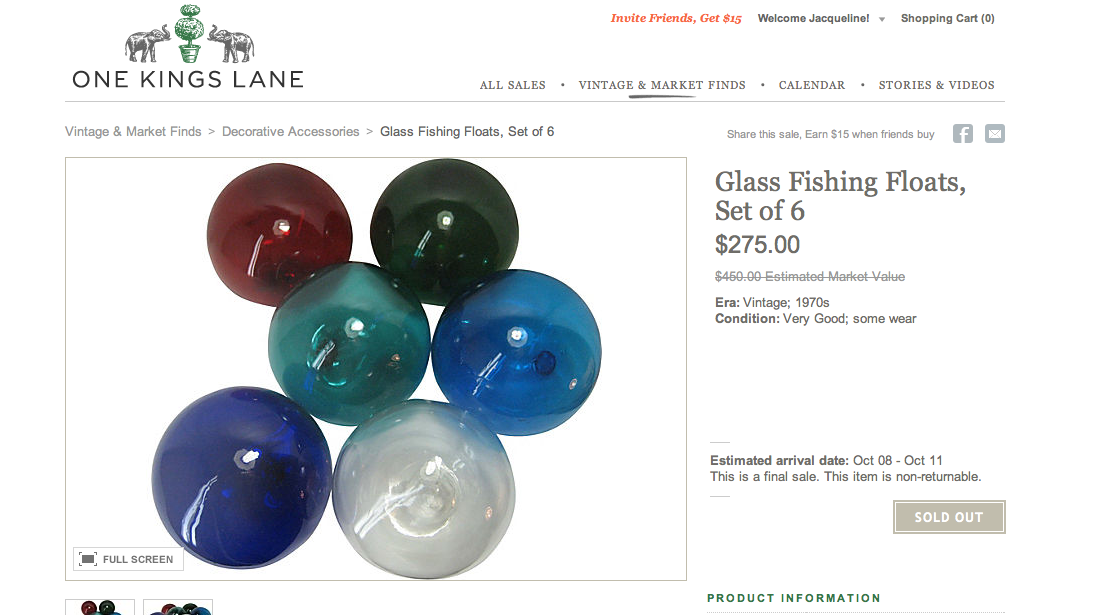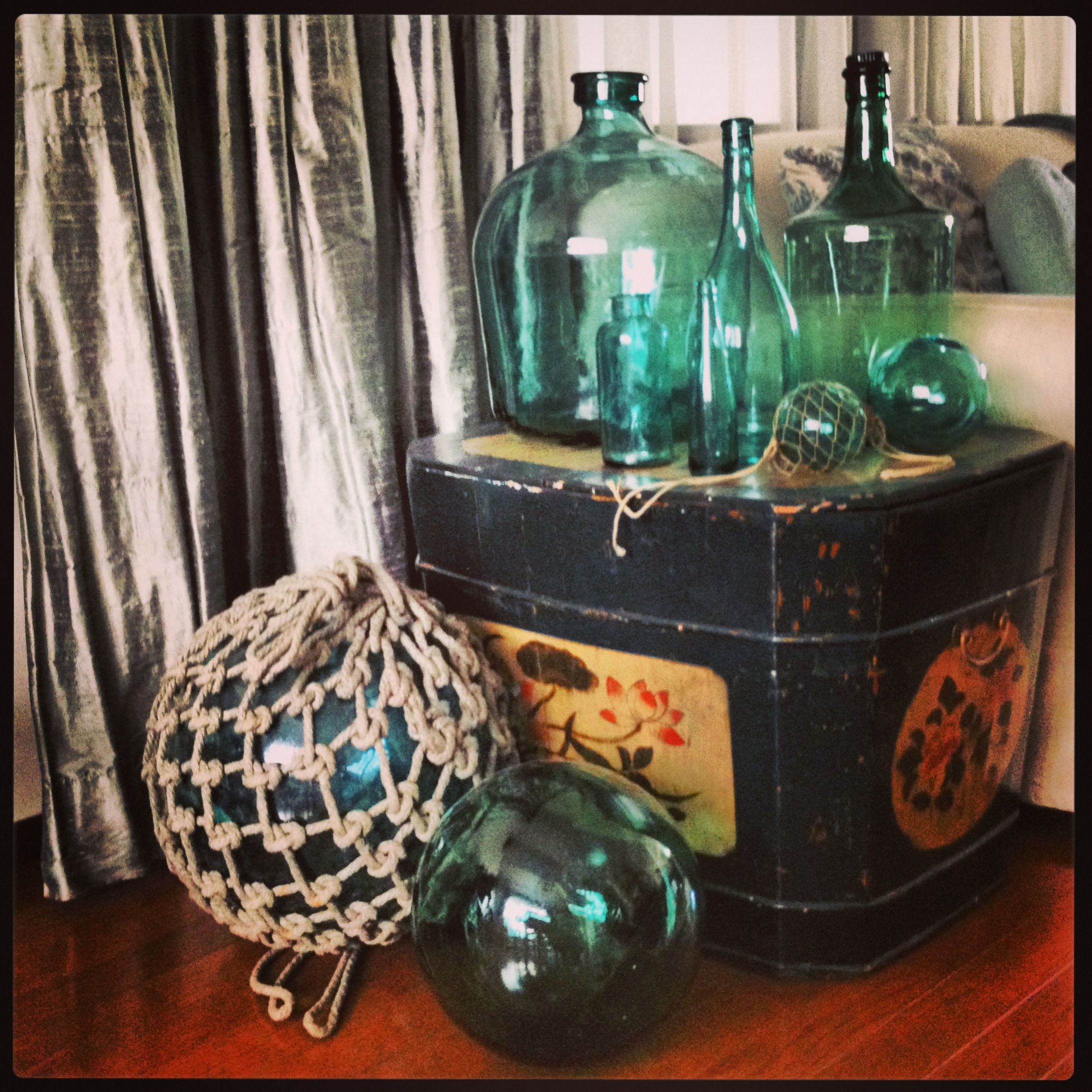So I’ve been out shopping for dining room tables and heaven forfend, it looks like I might actually be buying a new one, not an antique. The table is so beautifully made and lovingly finished that mixed in with other pieces you might never even notice. But truthfully, outside of upholstered pieces and IKEA Billy bookcases, I’m not sure I own any new furniture. I can tell you where and when every item was purchased and the story behind it. Which leads me to wonder if that is only my personal obsession? Does provenance really matter to you? Do you care if something is actually antique? Is it looking good and looking right that matters? Is it the story of finding something that matters? Is it the right price?
For me, nothing reflects those questions back more that my addiction to blue-green glass bottles and fishing floats. Having been in Tokyo for the last nine years I have been buying the Japanese variety almost exclusively – you never know a Chinese or Korean piece could have slipped in, but I don’t think so. I look for glass that has distinctive characteristics, from makers marks to hand blown evidence like bubbles and I particularly love wonky necks, spouts and glass screw tops. The floats I have gathered from shrine sale markets and from fisherman directly as they are considered obsolete and can sometimes be traded for a really yummy box of cookies. But funnily enough, while I consider that I have found floats “at the source,” many people think that beach combing them – finding them washed up on the shore – is the only true way to collect them.
The popularity of this kind of glass has skyrocketed in the last few years to the point of becoming almost ubiquitous. Floats and bottles are in all the catalogs and on all the flash sale sites. So the question is, does provenance matter?
At prices like these, I think the answer is most definitely yes. And if you read the fine print, it’s fairly fuzzy in its implications of age and history. We all know the colors are wrong and that these floats were never used, but if you like these colors do you care?
 What if you stumble across a store in Bali selling floats that arguably were made for the tourist trade? Does that make them more interesting or better than ones bought from a catalog back in the USA?
What if you stumble across a store in Bali selling floats that arguably were made for the tourist trade? Does that make them more interesting or better than ones bought from a catalog back in the USA?
For me personally, there is just no comparison to a variety of well used floats collected over time. The antique soba bowl holding them doesn’t hurt either. But you all knew I’d say that and I am not sure everyone would agree with me.
What about these large floats from Wisteria? Again, the fine print says handmade – which they may well be – but there is only an implication that these were used, because in fact, they were not. Note how conveniently the glass blowing pontil falls inside each float, giving it a perfect flat end so that you can style it nicely and easily on your bookshelf or coffee table – not something fishermen prioritized. But the color and texture of the glass looks lovely. The price isn’t half bad either, especially if you are aware that they are recently made and not antique.
But do you think it truly compares to the real thing?
Bottles with fishing style ropes have become more popular and we all covet that rope bottle lamp that Tom Scheerer and Steven Gambrel love to use. Both of them have perfected the way of blending something that looks old with things that actually are old to create a seamless whole. I’m not sure this bottle does that. And bottles with fishermen ropes seem a bit made up to me actually…
The really giant bottles I collect were often covered in protective wicker for transport. Called demijohns, this was the method of choice for transporting liquids for thousands of years – even the ancient Egyptians encased their bottles in papyrus. Over time, many of the bottles lost their degradable wicker casing. leaving just the bottle. While you can find wicker-cased ones all over Europe, I had never seen any of the Japanese ones – used mostly for sake and other alcohol – covered in anything. That is, until right before I left. Can you believe this charmer actually has a bit of ivy growing on it? Swoon-worthy!
New ones, like these from Pottery Barn, abound on the market. Again the fine print gives the impression of antiquity and use, but I am sure these bottles are new. Would you care? Or would you rather lug some back from that romantic trip in the south of France?
I’m finding the shapes and details of the mass market ones to be lacking in variety and interest compared to the ones I have hunted up. Variety really is another advantage of vintage and antique.
So before you start feeling bad for me that I have left the land of blue-green glass behind, take a look at one of my most recent Doha finds. Mostly likely Lebanese or from that region, these rustic forms of demijohns were used to transport regional liquids like olive oil. The protective wicker looks like a birds next and the bottle is crooked and handmade, just the way I like it. Since this photo it has cleaned up nicely and come to hang out with its new Japanese friends. The language barrier is slowing them down a bit, but I am sure they will get along fine.
If you think this post was just one big orgy of self-congratulation that my glass made it through the move intact, then you are correct. But I’d love to hear from you on this subject. Does provenance matter to you? Do you care about true antiquity?
If you want to read more about these treasures you can scroll through posts in the glass floats and glass bottles tags or even read the post that started it all: Buoys, Bottles and Bargains…the Rainy Day Special at Kawagoe











